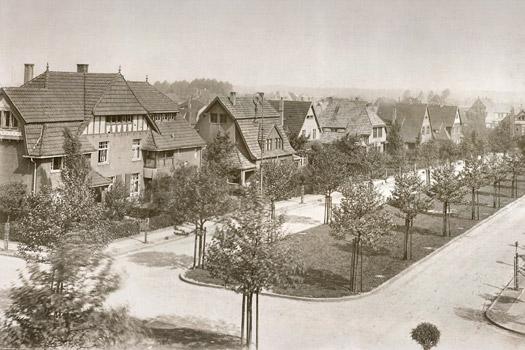
Arts and Crafts
Ausschnitt aus Impulstext
© Historisches Archiv Krupp
Kunst zurück zur Auswahl
The Teutoburgia settlement in Herne
Arts and Crafts - An English idea in the Ruhr Region
In 1908 the "Bochumer Verein für Bergbau and Gussstahlfabrikation" (Bochum Association for Mining and Cast Steel Manufacturing) was planning the Teutoburgia colliery, but it was clear that the peasantry communities Börnig and Holthausen would not be able to provide sufficient housing for the miners and their families. Thus the architect Otto Berndt from the Building Department of the Bochumer Verein drew up plans for both the mine and a workers' housing estate. He designed 21 efficient standard houses, and tried to give them an individual look that reflected pre-industrial handicraft technology, thus carefully avoiding the impression of efficient mass-production as exemplified by the steep roofs and the amount of timber framework mixed with brick and plaster surfaces. When the settlement was completed in 1923, then with about 460 apartments, this model colony resembled quite a picturesque village. In 1988 the "village" was modernised as part of the IBA Emscher Park.
Otto Berndt had been working for the Bochumer Verein before 1900; in this capacity, he planned the Jahrhunderthalle, constructed in Bochum in 1903. Inspiration for Berndt’s Teutoburgia settlement comes from England: since 1860 members of the Arts and Crafts Movement had been criticising industrialisation and urbanisation, and they advocated a simpler life in symbiotic working communities. They built houses on land that was perceived to be healthy; buildings harked back in their simplicity to mediaeval, Gothic architecture. Some elements of the single, double and row houses in Herne remind one of these English models.
The Teutoburgia settlement, which, like the mine, was built in 1909, shows parallels with the typical garden suburbs of the times: pleasant, green and varied; hardly two streets were alike. The time of workers' barracks and monotonous four-family houses was over. Inside, however, nothing had changed: here too, the often quite large miners’ families had to make do with the typical four small rooms - usually one of those being occupied by the grandparents, and another let out to a boarder whose rent was desperately needed.
Denkmale zum Impuls
Herne - Teutoburgia-Siedlung in Herne
Baumeister Otto Bernd, der schon 1903 für die Jahrhunderthalle in Bochum verantwortlich ... weiter
Bottrop - Gartenstadt Welheim
Die 1913 bis 1923 errichtete Siedlung Welheim ist bauliches Erbe der sogenannten ... weiter
